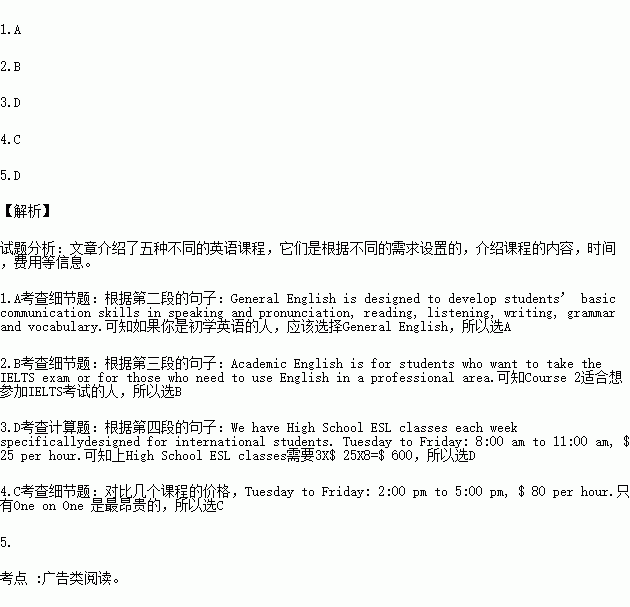题目内容
We offer five kinds of courses. Each course has been designed to help students according to their needs.
Course 1: General English
General English is designed to develop students’ basic communication skills in: Speaking and Pronunciation, Reading, Listening, Writing, Grammar and Vocabulary. Tuesday to Friday: 9:00 am to 11:00 am, $288 per week.
Course 2: Academic English
Academic English is for students who want to take the IELTS exam or for those who need to use English in a professional area. Monday to Friday: 4:00 pm to 5:00 pm, $ 320 per week.
Course 3: High School ESL
Why not make the most of your time studying in Australia with the help from TIES? We have High School ESL classes each week specifically designed for international students. Tuesday to Friday: 8:00 am to 11:00 am, $ 25 per hour.
Course 4: Night Classes
Do you want to improve your English and get the best possible results in your GRE test? We have two night classes each week designed to meet your needs. Tuesday and Thursday evenings: 8:30 pm to 10:30 pm, $ 60 per day.
Course 5: One on One
If you are interested in some One on One lessons with TIES teachers, we can design a course to meet your needs. One on One lessons can improve your English language skills more quickly and help students who want to take TOEFL. Tuesday to Friday: 2:00 pm to 5:00 pm, $ 80 per hour.
1. If you are an English beginner, you’d better choose________.
A. General English B. High School ESL
C. Night Classes D. Academic English
2.Which course would be helpful for students who want to take the IELTS exam?
A. Course 1. B. Course 2.
C. Course 3. D. Course 4.
3.How much will you pay if you spend two weeks taking the High School ESL course?
A.$ 200. B.$ 300. C.$ 500. D.$ 600.
4.What can we learn from One on One according to the passage?
A. Its lessons are given in the morning.
B. It’s especially designed for English beginners.
C. It’s more expensive than the other courses.
D. Its lessons are designed to only improve writing skills.
5.If you are only free in the morning, you may choose________.
A. Course 1 or Course 5 B. Course 3 or Course 4
C. Course 2 or Course 4 D. Course 1 or Course 3
 中考解读考点精练系列答案
中考解读考点精练系列答案 各地期末复习特训卷系列答案
各地期末复习特训卷系列答案 小博士期末闯关100分系列答案
小博士期末闯关100分系列答案


 e, rising sea levels and expansion of deserts in the subtropics(亚热带). Warming is expected to be greater over land than over the oceans and greatest in the Arctic, with the continuing loss of glaciers, permafrost and sea ice. Other likely changes include more frequent extreme weather events including heat waves, droughts, heavy rainfall with floods, heavy snowfall and species extinction due to great change of temperature. Bad effects on humans include the threat to food security from decreasing crop yields and the loss of populated(住人的) areas because of rising sea levels.
e, rising sea levels and expansion of deserts in the subtropics(亚热带). Warming is expected to be greater over land than over the oceans and greatest in the Arctic, with the continuing loss of glaciers, permafrost and sea ice. Other likely changes include more frequent extreme weather events including heat waves, droughts, heavy rainfall with floods, heavy snowfall and species extinction due to great change of temperature. Bad effects on humans include the threat to food security from decreasing crop yields and the loss of populated(住人的) areas because of rising sea levels.